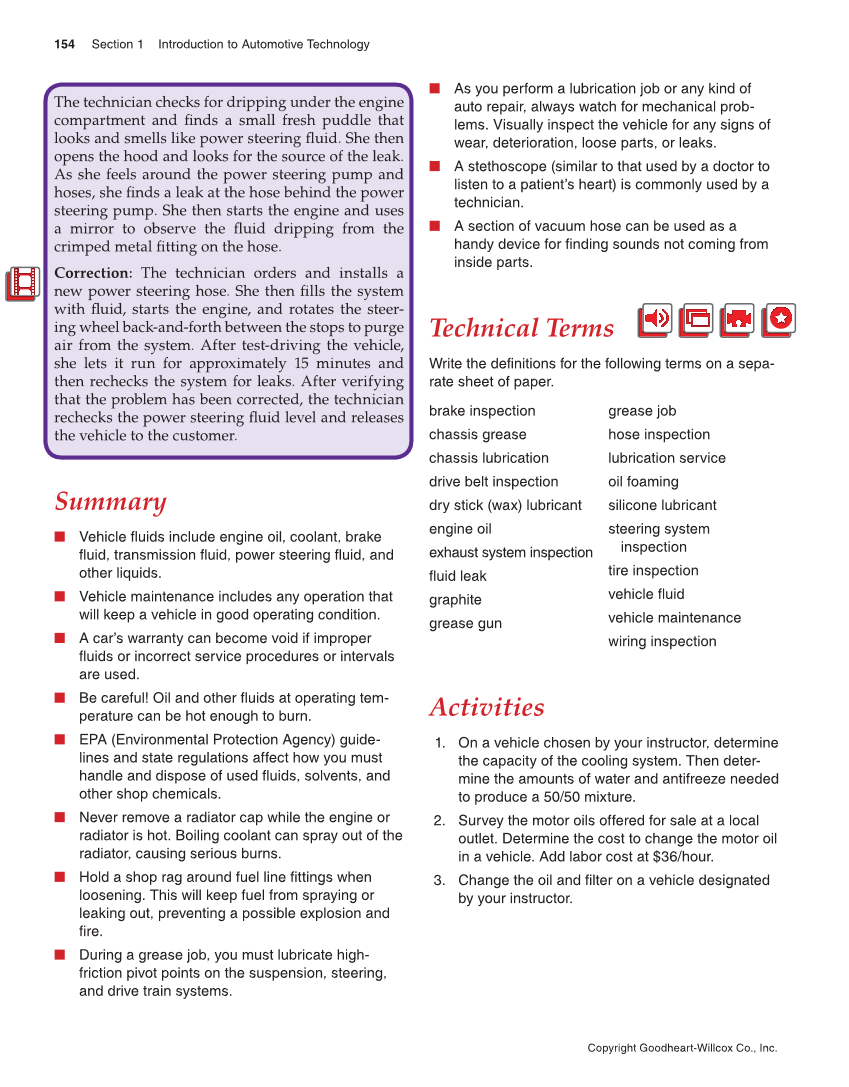154 Section 1 Introduction to Automotive Technology Copyright Goodheart-Willcox Co., Inc. The technician checks for dripping under the engine compartment and finds a small fresh puddle that looks and smells like power steering fluid. She then opens the hood and looks for the source of the leak. As she feels around the power steering pump and hoses, she finds a leak at the hose behind the power steering pump. She then starts the engine and uses a mirror to observe the fluid dripping from the crimped metal fitting on the hose. Correction: The technician orders and installs a new power steering hose. She then fills the system with fluid, starts the engine, and rotates the steer- ing wheel back-and-forth between the stops to purge air from the system. After test-driving the vehicle, she lets it run for approximately 15 minutes and then rechecks the system for leaks. After verifying that the problem has been corrected, the technician rechecks the power steering fluid level and releases the vehicle to the customer. Summary ■ Vehicle fluids include engine oil, coolant, brake fluid, transmission fluid, power steering fluid, and other liquids. ■ Vehicle maintenance includes any operation that will keep a vehicle in good operating condition. ■ A car’s warranty can become void if improper fluids or incorrect service procedures or intervals are used. ■ Be careful! Oil and other fluids at operating tem- perature can be hot enough to burn. ■ EPA (Environmental Protection Agency) guide- lines and state regulations affect how you must handle and dispose of used fluids, solvents, and other shop chemicals. ■ Never remove a radiator cap while the engine or radiator is hot. Boiling coolant can spray out of the radiator, causing serious burns. ■ Hold a shop rag around fuel line fittings when loosening. This will keep fuel from spraying or leaking out, preventing a possible explosion and fire. ■ During a grease job, you must lubricate high- friction pivot points on the suspension, steering, and drive train systems. ■ As you perform a lubrication job or any kind of auto repair, always watch for mechanical prob- lems. Visually inspect the vehicle for any signs of wear, deterioration, loose parts, or leaks. ■ A stethoscope (similar to that used by a doctor to listen to a patient’s heart) is commonly used by a technician. ■ A section of vacuum hose can be used as a handy device for finding sounds not coming from inside parts. Technical Terms Write the definitions for the following terms on a sepa- rate sheet of paper. brake inspection chassis grease chassis lubrication drive belt inspection dry stick (wax) lubricant engine oil exhaust system inspection fluid leak graphite grease gun grease job hose inspection lubrication service oil foaming silicone lubricant steering system inspection tire inspection vehicle fluid vehicle maintenance wiring inspection Activities 1. On a vehicle chosen by your instructor, determine the capacity of the cooling system. Then deter- mine the amounts of water and antifreeze needed to produce a 50/50 mixture. 2. Survey the motor oils offered for sale at a local outlet. Determine the cost to change the motor oil in a vehicle. Add labor cost at $36/hour. 3. Change the oil and filter on a vehicle designated by your instructor.
